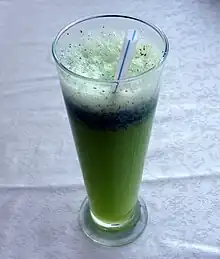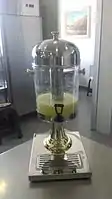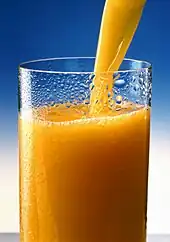Lemonade is a sweetened lemon-flavored drink.
There are varieties of lemonade found throughout the world.[1] In North America and South Asia, cloudy lemonade is a common variety. It is traditionally a homemade drink using lemon juice, water, and a sweetener such as cane sugar, simple syrup, maple syrup or honey.[2] In the United Kingdom, Ireland, Central Europe, South Africa, Australia, and New Zealand, a carbonated lemonade soft drink is more common. Despite the differences between the drinks, each is known simply as "lemonade" in countries where it is dominant.
The suffix "-ade" may also be applied to other similar drinks made with different fruits, such as limeade, orangeade, or cherryade.[3]
History
A drink made with lemons, dates, and honey was consumed in Mamluk Egypt, including a lemon juice drink with sugar, known as qatarmizat.[4] In 1676, a company known as Compagnie de Limonadiers sold lemonade in Paris.[5] Vendors carried tanks of lemonade on their backs and dispensed cups of the soft drink to Parisians.[6]
While carbonated water was invented by Joseph Priestley in 1767 (with his pamphlet Directions for Impregnating Water with Fixed Air published in London in 1772),[7] the first reference found to carbonated lemonade was in 1833 when the drink was sold in British refreshment stalls.[8] R. White's Lemonade has been sold in the UK since 1845.[9]
Varieties
Cloudy lemonade
The predominant form of lemonade found in the US, Canada, and India, cloudy lemonade, also known as traditional or old fashioned lemonade in the UK and Australia, is non-carbonated and made with fresh lemon juice; however, commercially produced varieties are also available. Generally served cold, cloudy lemonade may also be served hot as a remedy for congestion and sore throats,[10] frozen, or used as a mixer.

Traditionally, children in US and Canadian neighborhoods start lemonade stands to make money during summer. The concept has become iconic of youthful summertime Americana to the degree that parodies and variations exist across media. References can be found in comics and cartoons such as Peanuts, and the 1979 computer game Lemonade Stand.[11]
Pink lemonade
A popular variation of traditional lemonade, pink lemonade, is created by adding additional fruit juices, flavors, or food coloring to the recipe. Most store-bought pink lemonade is simply colored with concentrated grape juice or dyes.[12]
A 1912 obituary credited the invention of pink lemonade to circus worker Henry E. "Sanchez" Allott, saying he had dropped in red cinnamon candies by mistake.[13]
Another origin story credits another circus worker, Pete Conklin, in 1857. His brother George Conklin tells the story in his 1921 memoir. According to the story, Conklin's lemonade was a mixture of water, sugar and tartaric acid, with the tub garnished with a single lemon that he repeatedly used for the season. One day, he ran out of water. Searching desperately, he found a tub of water a bareback rider had recently used to rinse her pink tights. Adding in the sugar, acid and remaining bits of lemon, he offered the resulting mixture as "strawberry lemonade" and saw his sales double.[12][14]
Clear lemonade

The predominant form of lemonade in the UK, Ireland, France, Germany, Switzerland, South Africa and Australia is a clear, lemon-flavoured carbonated beverage. Schweppes, R. White's Lemonade and C&C are common brands, and shops usually carry a store-branded lemonade as well.[9] Schweppes uses a blend of lemon and lime oils.[15] Other fizzy drinks, soft-drinks (or pop) which are both lemon and lime flavoured may also sometimes be referred to as lemonade, such as Sprite and 7 Up. There are also speciality flavours, such as Fentimans Rose Lemonade, which is sold in the UK, the US, and Canada. Shandy, a mixture of beer and clear lemonade, is often sold pre-bottled, or ordered in pubs.[16]
Brown lemonade
There are various drinks called brown lemonade. In Northern Ireland, brown lemonade is flavoured with brown sugar.[17] A variant from Venezuela has cane sugar and lime.[18]
Other varieties
In India and Pakistan, where it is commonly known as nimbu paani, and in Bangladesh, lemonades may also contain salt or ginger juice called lebur shorbot.[19] Shikanjvi is a traditional lemonade from this region, and can also be flavored with saffron, cumin and other spices.[20][21][22]
Limonana, a type of lemonade made from freshly squeezed lemon juice and mint leaves, is a common summer drink in the Middle East.[23] In Northern Africa, a drink called cherbat is made of lemon, mint, and rose water.
Switcha is a version of the drink made in the Bahamas and Turks & Caicos that can also be made with limes instead of lemons.
Citron pressé

In France, it is common for bars or restaurants to offer citron pressé, also called citronnade, an unmixed version of lemonade in which the customer is given lemon juice, syrup and water separately to be mixed in their preferred proportions.[24]
Gallery

 Drink dispenser containing lemonade.
Drink dispenser containing lemonade.
See also
References
- ↑ "LEMONADE – meaning in the Cambridge English Dictionary". dictionary.cambridge.org. Archived from the original on October 25, 2018. Retrieved October 25, 2018.
- ↑ "History of Lemonade". Buzzle. Archived from the original on October 9, 2015. Retrieved December 26, 2015.
- ↑ Smith, Andrew F. (October 28, 2013). Food and Drink in American History: A "Full Course" Encyclopedia. ABC-CLIO. ISBN 978-1-61069-233-5. Archived from the original on May 8, 2016. Retrieved December 27, 2015.
- ↑ "History of lemonade". Clifford A. Wright. March 12, 2012. Archived from the original on March 12, 2012. Retrieved December 26, 2015.
- ↑ "The Victoria Advocate – Google News Archive Search". news.google.com. Archived from the original on January 23, 2016. Retrieved December 26, 2015.
- ↑ "Soft Drink". Encyclopædia Britannica. Archived from the original on May 5, 2015. Retrieved April 20, 2022.
- ↑ Priestley, Joseph. Directions for impregnating water with fixed air; in order to communicate to it the peculiar spirit and virtues of Pyrmont water, and other mineral waters of a similar nature. London: Printed for J. Johnson, 1772.
- ↑ Emmins, Colin (1991). Soft drinks – Their origins and history (PDF). Great Britain: Shire Publications Ltd. p. 8 and 11. ISBN 0-7478-0125-8. Archived (PDF) from the original on March 4, 2016. Retrieved December 27, 2015.
- 1 2 "Chester homeless charity teams up with lemonade brand". Chester Chronicle. October 8, 2017. Archived from the original on October 8, 2017. Retrieved October 8, 2017.
- ↑ "Is Lemonade Good for Sick People to Drink While They Have the Flu?". LIVESTRONG.COM. Archived from the original on December 27, 2015. Retrieved December 26, 2015.
- ↑ Apple Computer (1979), Lemonade Stand (1979) (Apple), retrieved May 3, 2020
- 1 2 "The Unusual Origins of Pink Lemonade | History | Smithsonian". Smithsonianmag.com. August 16, 2016. Archived from the original on October 7, 2019. Retrieved October 13, 2019.
- ↑ "Inventor of pink lemonade dead" (PDF). The New York Times. September 18, 1912. p. 11. Archived (PDF) from the original on January 9, 2021. Retrieved September 21, 2007.
- ↑ Nickell, Joe. Secrets of the Sideshows, 978-0813123585, University Press of Kentucky, 2005. pp. 31–32.
- ↑ "Product description". Archived from the original on February 9, 2019. Retrieved February 8, 2019.
- ↑ "shandy | Origin and meaning of shandy by Online Etymology Dictionary". www.etymonline.com. Archived from the original on November 8, 2021. Retrieved November 8, 2021.
- ↑ "Brown Lemonade". CooksInfo. Archived from the original on February 5, 2020. Retrieved March 18, 2020.
- ↑ Locklin, Kristy (October 18, 2020). "Cilantro & Ajo brings Venezuelan street food to Pittsburgh's South Side". Next Pittsburgh. Archived from the original on February 5, 2020. Retrieved February 5, 2020.
- ↑ "Summer cooler: Try this refreshing lemonade with a twist". The Indian Express. May 19, 2021. Retrieved September 17, 2023.
- ↑ Jiggs Kalra, Pushpesh Pant, Classic cooking of Punjab Archived May 21, 2016, at the Wayback Machine, Allied Publishers, 2004, ISBN 978-81-7764-566-8
- ↑ Julie Sahni, Indian regional classics: fast, fresh, and healthy home cooking Archived April 25, 2016, at the Wayback Machine, Ten Speed Press, 2001, ISBN 1-58008-345-5, 9781580083454, "... Ginger Limeade (Shikanji) ..."
- ↑ Mint lemonade / pudina shikanji / pudina nimbu paani / masala lemonade Archived June 19, 2018, at the Wayback Machine. Indian Recipe Secrets. June 16, 2018. Retrieved August 29, 2018.
- ↑ "Limonana: Not your average lemonade". Zomppa. August 29, 2011. Archived from the original on March 26, 2019. Retrieved May 28, 2012.
- ↑ Rough Guides Snapshot (April 12, 2012). Poitou-Charentes and the Atlantic Coast Rough Guides Snapshot France (includes Poitiers, La Rochelle, Île de Ré, Cognac, Bordeaux and the wineries). Rough Guides Limited. p. 96. ISBN 978-1-4093-6293-7. Archived from the original on March 23, 2017. Retrieved November 3, 2016.
External links
- Of the Street Sale of Ginger-Beer, Sherbet, Lemonade,&C., from London Labour and the London Poor, Volume 1, Henry Mayhew, 1851; subsequent pages cover the costs and income of street lemonade sellers.

.JPG.webp)
